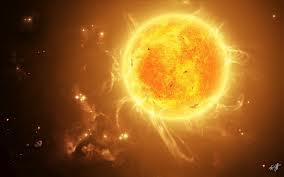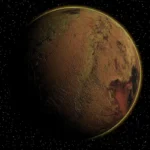
The Sun is a star found at the center of the Solar System.
It makes up around 99.86% of the Solar System’s mass.
At around 1,392,000 kilometres (865,000 miles) wide, the Sun’s diameter is about 110 times wider than Earth’s.
Around 74% of the Sun’s mass is made up of hydrogen. Helium makes up around 24% while heavier elements such as oxygen, carbon, iron and neon make up the remaining percentage.
Light from the Sun reaches Earth in around 8 minutes.
The Sun’s surface temperature is around 5500 degrees Celsius (9941 degrees Fahrenheit), so pack plenty of sunscreen if you plan on visiting (remembering that the average distance from the Sun to the Earth is around 150 million kilometers).
The Sun’s core is around 13600000 degrees Celsius!
The Sun generates huge amounts of energy by combining hydrogen nuclei into helium. This process is called nuclear fusion.
Because of the Sun’s huge influence on Earth, many early cultures saw the Sun as a deity or god. For example, Ancient Egyptians had a sun god called Ra while in Aztec mythology there is a sun god named Tonatiuh.
The Sun produces a solar wind which contains charged particles such as electrons and protons. They escape the Sun’s intense gravity because of their high kinetic energy and the high temperature of the Sun’s corona (a type of plasma atmosphere that extends into space).
Planets with strong magnetic fields such as Earth manage to deflect most of these charged particles as they approach.
A solar eclipse occurs when the Moon is between the Sun and the Earth.
The Sun is one among the 200 billion stars in our Milky Way galaxy.
The Sun is one among the 6000 stars, which is visible to naked eye from the Earth.
The mass of Sun is 1.989 x 1030 kg (Approximately 2 million trillion trillion kilograms).
The Sun’s energy output is 386 billion billion megawatt.
The Earth receives 94 billion megawatt of energy from Sun. This is equivalent to 40,000 times the power requirement of United states.
The reaction taking place in Sun is nuclear fusion, same as a Hydrogen bomb.
Each second 700 million tons of Hydrogen are converted to 695 million tons of Helium and 5 million tons of energy in the form of gamma rays.
Each second the Sun loses 5 million tons of material.
The Sun’s temperature at its core is 14 million Kelvin.
The pressure at the Sun’s core is 340 billion times the pressure at the Earth’s atmosphere.
The density of matter at the Sun’s core is about 150 times the density of water in the Earth.
It takes up to 50 million years for the energy produced at the core of the Sun to reach its surface.
If the Sun were to stop producing energy today, it would take 50 million years for significant effects to be felt at Earth.
If a drop sized matter from the core of the Sun is placed on the surface of the Earth, no living organism will survive for a distance of 150 km from that drop.
The diameter of Sun is equivalent to the diameter of 109 earths.
The surface area of Sun is equivalent to that of 11990 earths.
The volume of Sun is equivalent to the volume of 1.3 million earths.
If the Sun were the size of a beach ball then Jupiter would be the size of a golf ball and the Earth would be as small as a pea.
The gravity at the surface of Sun is 28 times that of Earth.
A man weighing 60 kg in the Earth will weigh 1680 kg in the Sun.
The Sun makes up 99.86% of the mass of the solar system.
Unlike the Earth, the Sun is completely gaseous, there is no solid surface on the Sun.
By weight, Sun comprises of 73% hydrogen, 25% helium, 1.5% carbon, nitrogen, and oxygen, and 0.5% all other elements.
By volume, Sun comprises of 92.1% hydrogen, 7.8% helium and 0.1% all other elements.
The Sun is at a mean distance of 149.60 million km from Earth.
The light takes 8.3 minutes to travel from the Sun to Earth.
The Sun’s gravitational pull is so strong that, even Pluto, a planet 5.9 billion kilometer away from Sun, is kept in it’s orbit.
Escape velocity of any planet or star is the velocity required for any object to escape from the gravitational pull of that planet or star. The escape velocity of the Sun is 2.22 million km/hr.
The light takes 5.5 hours to travel from the Sun to Pluto, the outer most planet.
Proxima Centauri (Alpha Centauri C) is the star nearest to Sun. It is 4.3 light years away from Sun.









